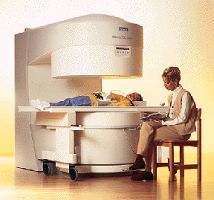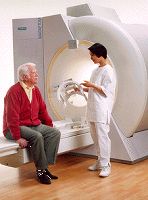MRI, like CT, requires the patient to lie still on a special table inside the scanning gantry for ten to thirty minutes. However, during the conventional "high-field" MR exam, patients must lie completely still for shorter durations of five to ten minutes at a time. The CT exam may only require patient cooperation for a few seconds to a few minutes at a time. Due to the longer examination times of MR and the closed nature of the cylindrical magnet used in traditional "high-field" MR equipment (0.5 to 1.5 Tesla magnetic field strength), some patients who undergo MR may experience claustrophobic anxiety.

A mother reads to her daughter during an Open MR examination
Technical innovation is bringing new, "friendlier" MR designs like "open MR" and "short-bore MR", into routine clinical use. The new "open" or "C-shaped" MR systems (0.2 to 0.3 Tesla field strength) are typically open on all sides and improve a person's MR experience by lessening claustrophobia. Also becoming available are new versions of conventional "high-field" (cylindrical) MR systems with shorter magnets and more patient friendly (wider and shorter) aperture designs. These new "short-bore" systems promise to also further minimize patient anxiety about MR examination.

The MR technologist consoles a senior prior to an MR examination on a new "short bore system"



